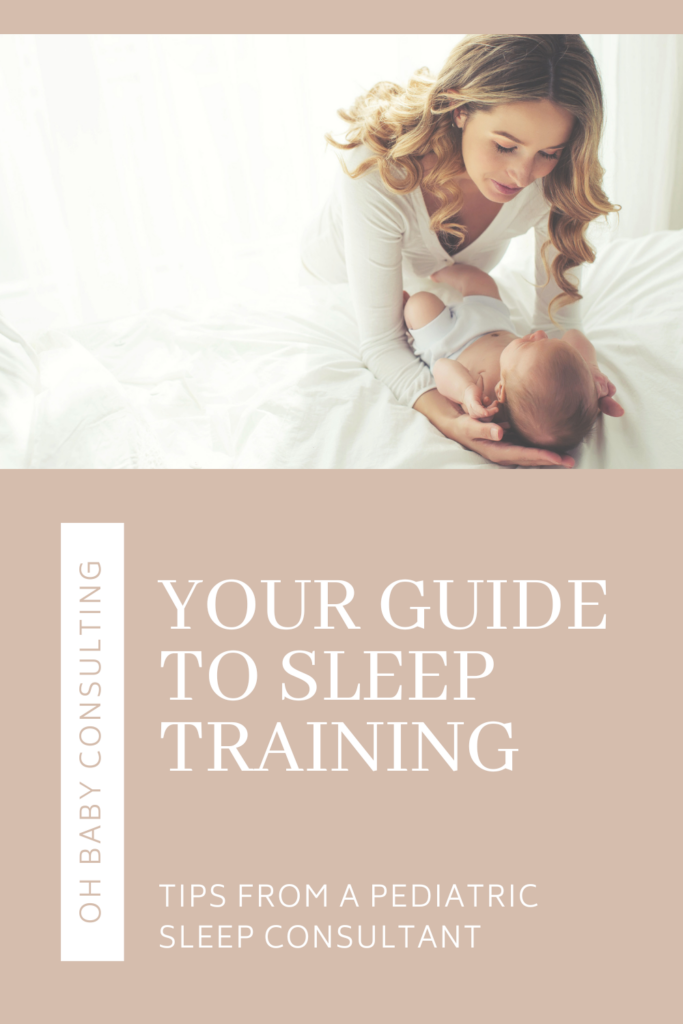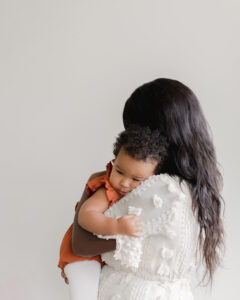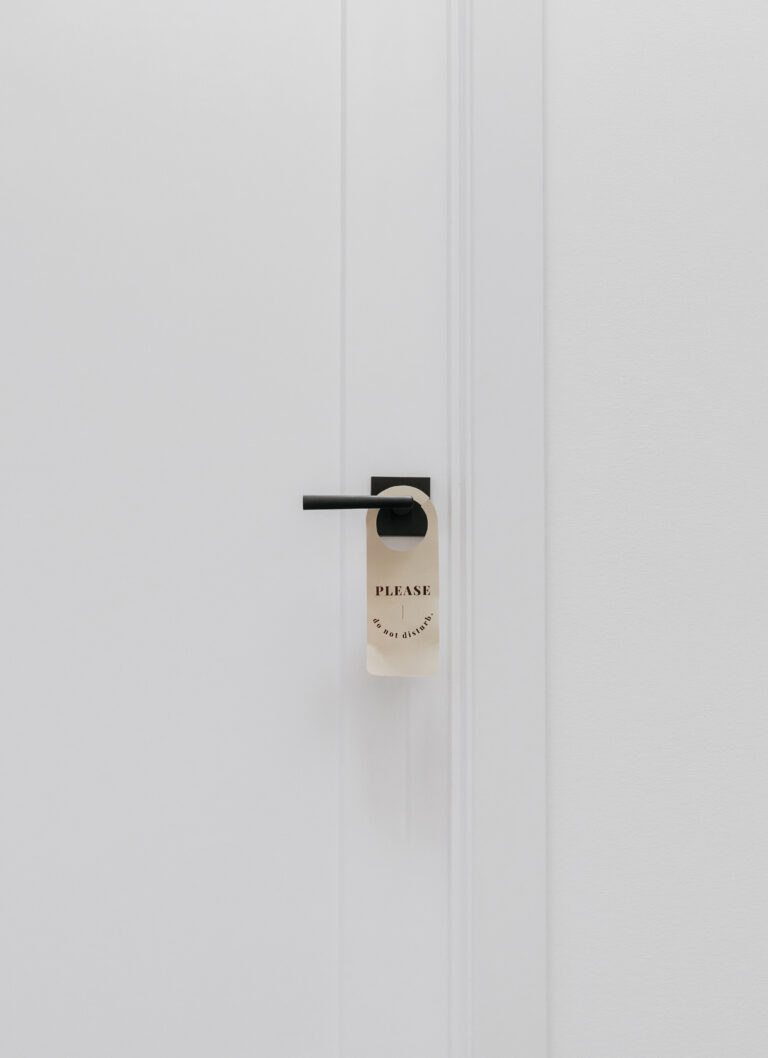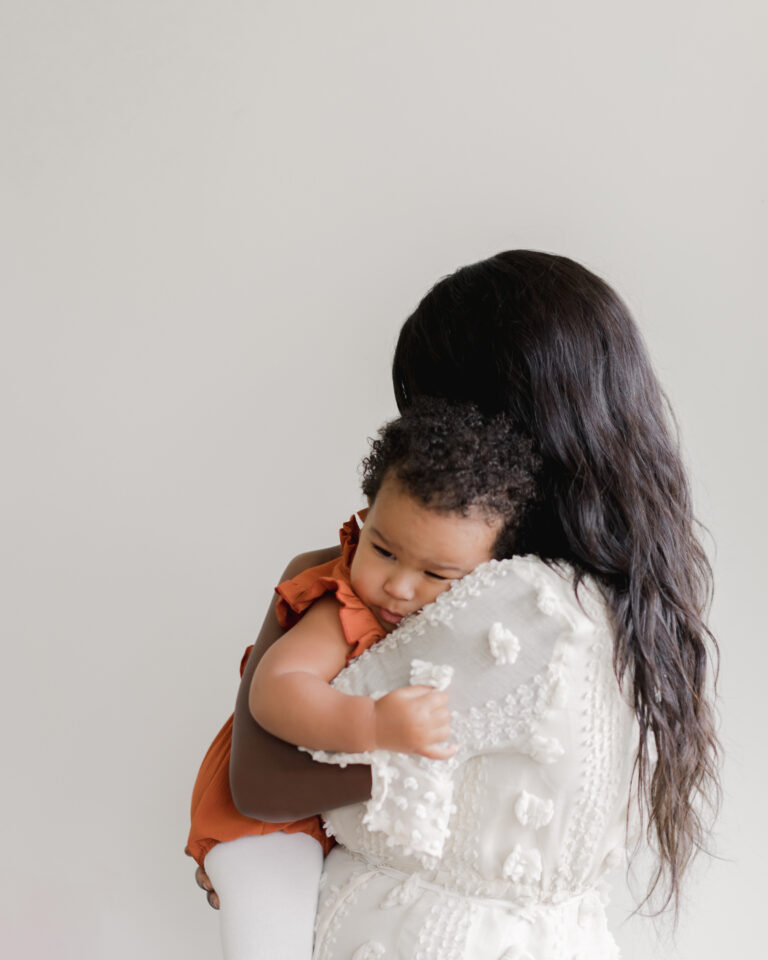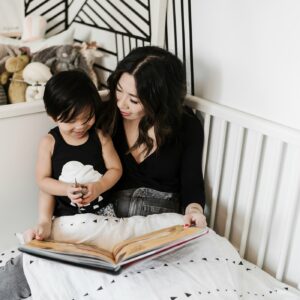You may have heard of sleep training but are wondering exactly what it is and what it involves. You may be wondering about sleep training methods and which one is right for your situation.
I want to share all about sleep training: the myths and misconceptions, the truths and realities, and the sleep training methods I use with families.
What is Sleep Training?
Sleep training involves changing sleep habits. The subtext of that usually implies moving from a sleep approach that relies on assisting your child to sleep to one that teaches them to fall asleep independently. Independent sleep is important because sleep occurs in cycles, and oftentimes whatever your child needed to fall asleep at bedtime (feeding, rocking, bouncing, etc.) will be needed again in the middle of the night in order to connect into another sleep cycle.
Parents choose to sleep train when their current sleep strategies aren’t working for them.
Bedtime takes hours
Middle-of-the-night wake ups are frequent
Other caregivers cannot soothe baby
Parents feel “touched-out”
Naps are short and a struggle
Quality of life is suffering
Things feel unsustainable
Everyone needs more sleep
By making a change to their current sleep situation, families are able to get the sleep they deserve.
Parents can lay their child down in their bed or crib and walk out with confidence knowing that within 10 minutes, their child will be asleep.
Parents can enjoy their evenings without fear of their child waking up and needing help getting back to sleep.
Everyone in the family is reliably able to get a full night of unbroken sleep.
Parents aren’t left guessing at what daytime naps will look like: their child is on a daytime sleep schedule and naps predictably.
Learning to sleep independently – like any other developmental skill – takes practice, and there are many different ways to approach the process. I want to help you understand how to sleep train your child if you choose to do so.
Creating a Sleep Training Plan
Before you begin sleep training your child, you want to make sure you have a plan. This plan should include things like:
- An understanding of your child’s current sleep props/sleep strategies and why they may have become problematic.
- An age-appropriate schedule that includes day & night sleep needs, appropriate number of naps and their lengths, and when & where naps should happen.
- An understanding of appropriate bedtime routines that support your new goals.
- A step-by-step plan for how to lay your child down awake at bedtime and respond to any protests that will inevitably occur. This includes if, when, and how to intervene, what interventions look like, how long to try, and how to assess progress or know when to change course.
- A plan for handling middle-of-the-night wake ups including whether or not you will be doing overnight feeds.
- A plan for daytime naps including when and where to offer them, how to respond to any protests, how long to try, and how to handle a short nap or nap refusal.
As you can see, your sleep training plan should include a number of important components to make the process as easy & stress-free on you and your child as possible.
The last 3 bullets – and arguably the most discussed and recognizable piece of the sleep training puzzle – speak to your chosen sleep training method. And while my belief is that the sleep training method is the least important part of your sleep training plan, it is the piece that receives the most attention. So, I want to outline the most common methodology options and share which one(s) I use with families both in one-on-one coaching and what you’ll find inside Oh Baby Sleep Course.
Sleep Training Methods
Contrary to popular belief, sleep training is not synonymous with “Cry it Out”. The Cry it Out Method (aka the Extinction Method) is one option for sleep training, but it is not the only option.
However, there is a difference between The “Cry it Out” Method and crying during sleep training. You can read more about this here.
There is a spectrum of sleep training methods ranging from least involved to most involved. If you’re considering sleep training, you need to choose a method that that aligns with your family’s needs.
THE “CIO”/ EXTINCTION METHOD
The Cry-it-Out Method (“CIO”) is also known as the Extinction Method. However, in conversations about sleep training, the term “cry it out” is often misused.
“Cry it out” is not letting your child cry for two or five minutes and then going to check on them; it is when you lay your child down awake at bedtime, leave the room, and don’t go back in until the next morning.
This method is a valid, effective, and safe option for families who want a quick “rip-the-bandaid” approach to making sleep changes. When done correctly, this method can work in just a couple of nights. However, it is a method that many families have a hard time sticking to because it feels too extreme.
CHECK-INS / FERBER / CONTROLLED CRYING
A “check-in” method is going to be the next step on the spectrum. It involves laying your child down awake at bedtime and returning to check on them at various timed intervals until they fall asleep.
There are so many variations of a check-in method, so make sure you have a clear understanding of the following:
- How long are you waiting between check-ins?
- Does that amount of time stay consistent or increase?
- Does the waiting time ever decrease?
- How do you determine when to set the timer?
- What do you do when you go for a check-in?
- What if the check-ins aren’t helping?
- How long do you try for?
Families like this method because, when done correctly and with consistency, it can work quickly and it gives parents a chance to connect with and comfort their child during the learning process.
I teach a version of a check-in method inside Oh Baby Sleep Course & use this method often when customizing plans for families.
I’m a big fan of making sure your plan is 100% thorough so that you can have confidence in your responses and your child does not become confused. That’s why in my plans, you’ll receive answers to all the above questions!
THE CHAIR METHOD / CAMPING OUT
The next method on the spectrum involves you staying in your child’s room as they fall asleep.
There are different variations of and approaches to this method as well. You’ll want to know where to sit, how to intervene, and how to gradually remove yourself from your child’s room as they become a more confident independent sleeper.
Families like this method because they don’t have to actually leave the room when their child is crying. This gives parents who are more sensitive to crying some peace of mind around the process as they are able to witness their child developing independent sleep strategies right before their eyes.
At Oh Baby, I often use a “stay in the room” method with families and expect to see results within 1-2 weeks.
PICK-UP, PUT-DOWN / GRADUAL PROP SUBSTITUTION & REMOVAL
The sleep training methods with the most intervention involve some variation of either slowly removing sleep props/associations over the period of many months or picking up your child immediately upon any crying and returning them to the crib once they are calm (+ repeating until they fall asleep).
While these methods are the most hands-on and are an effort to get as close to a “no tears” approach to sleep training as possible, they can often take 4-12 weeks to work and require a lot of patience and diligence on the part of the parent to stay consistent.
It is also important to note that more involved does not automatically mean “more gentle” or even less crying – it truly just means more hands-on. Some babies do better with less interaction and for those babies, Extinction or Check-Ins may be actually more “gentle” and yield less crying in the long run.
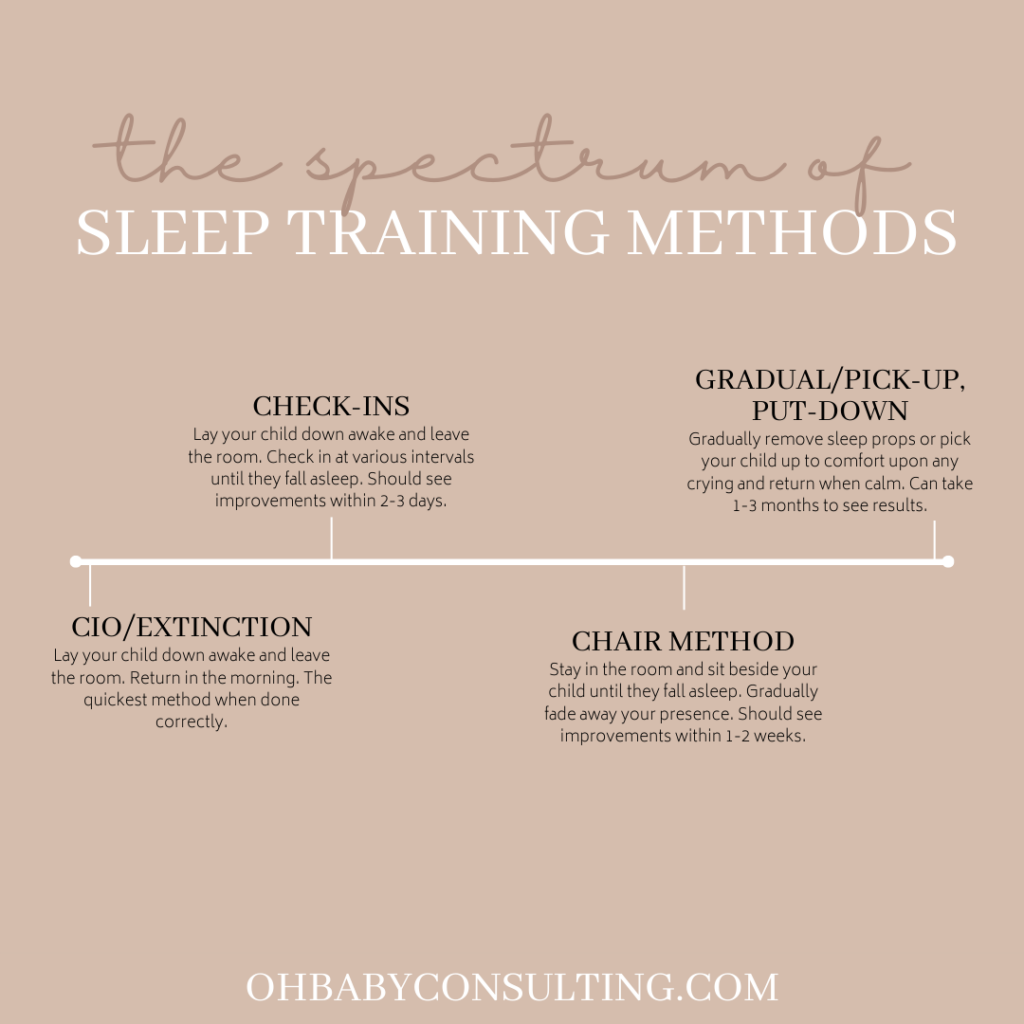
The Oh Baby Approach
As I mentioned, I tend to use methods that are situated nicely in the middle of the two ends of the spectrum. When I work one-on-one with families, I can choose and personalize a method based on their child’s age and developmental stage, sleep history and struggles, family dynamics and comfort, and their overall goals.
I truly believe that regardless of how much intervention you plan for during sleep training, there really is no such thing as a “no cry” approach. Your child is human. We cannot stop humans from expressing their feelings when they are in the midst of changing how they sleep. It’s valid for children to have big feelings around changes, and it’s unfair of us to try to control that form of self-expression.
But what we CAN do is have a PLAN to respond to the protests. A plan that involves responding intentionally and in a regulated way to hold space and support vs. responding chaotically or frenetically and doing a circus act to make tears stop. And though having a plan in place does often result in less crying overall, we cannot control to what degree your child is going to protest their feelings about change. This is my sleep training philosophy.
To read more about crying during sleep training, visit the resources below:
Crying + Sleep Training: What I Want You To Know
Crying During Sleep Training
I want you to close your eyes and picture your life a month from now. Imagine that…
- Your child is on an age-appropriate and predictable daytime schedule. You have dedicated time built into your day to get things done or enjoy some “me” time!
- You no longer dread bedtime and instead look forward to it as a peaceful, and joyful part of the day. Bedtime battles are a thing of the past.
- Your child falls asleep easily. It no longer takes hours to get them to settle and you don’t have endless false starts.
- Your child sleeps through the night! You feel confident that if they were to wake, it would be because they truly needed something, not just because they weren’t able to fall back to sleep on their own.
- You’re no longer guessing whether you’re doing things right; you’re confident about your child’s sleep.
- You can actually enjoy a date night with your partner or a GNO with your friends because anyone can put your child to bed.
- You’re getting the sleep your family deserves!
If these are the things you’re wishing for but you feel like they are out of reach, I promise you they can be your reality.
If you’re looking for sleep support, I encourage you to check out my coaching packages (for a personalized approach) or Oh Baby Sleep Course. Your family deserves to be happy, healthy, and well-rested, and I’d love to be a part of your journey.
